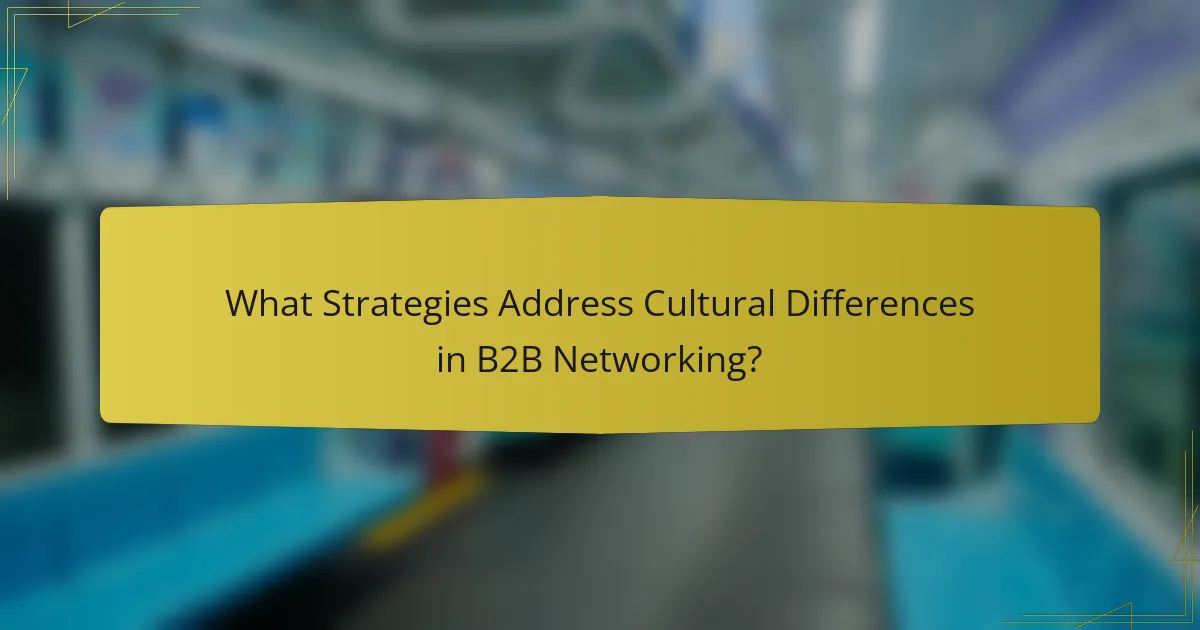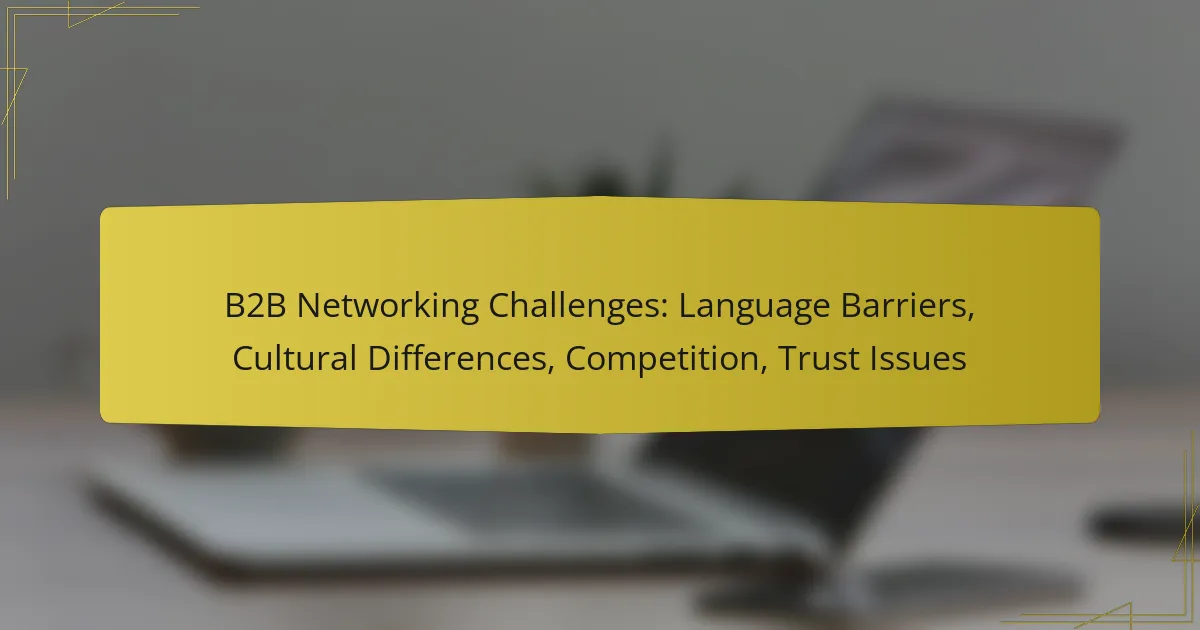B2B networking presents a range of challenges that can impede successful collaboration and relationship development. Among these challenges are language barriers, cultural differences, competition, and trust issues, each necessitating tailored strategies for effective navigation. Addressing these obstacles is crucial for fostering meaningful connections and achieving business success in a global marketplace.

What Are the Key B2B Networking Challenges?
B2B networking faces several significant challenges that can hinder effective collaboration and relationship building. Key issues include language barriers, cultural differences, competition, and trust issues, each requiring specific strategies to navigate successfully.
Language barriers
Language barriers can create misunderstandings and miscommunications in B2B networking. When partners speak different languages, it may lead to confusion over terms, expectations, and agreements.
To overcome language barriers, consider using professional translation services or hiring bilingual staff. Additionally, employing clear and simple language can help facilitate better understanding, reducing the risk of costly errors.
Cultural differences
Cultural differences can significantly impact business interactions and networking. Variations in communication styles, business etiquette, and decision-making processes can lead to friction if not acknowledged.
To navigate cultural differences, invest time in researching the cultural norms of your partners. Understanding local customs and practices can foster respect and improve collaboration. For example, in some cultures, indirect communication is preferred, while others value directness.
Competition
Competition can pose a challenge in B2B networking, as companies may be hesitant to share information or collaborate with rivals. This reluctance can stifle innovation and limit opportunities for partnerships.
To mitigate competitive tensions, focus on building relationships based on mutual benefits. Highlighting shared goals and emphasizing collaboration over competition can create a more open environment for networking.
Trust issues
Trust issues can undermine B2B networking, making it difficult to establish strong partnerships. Concerns about reliability, integrity, and transparency can hinder collaboration and information sharing.
Building trust requires consistent communication and delivering on promises. Engage in regular follow-ups and be transparent about your business practices. Consider initiating small projects to demonstrate reliability before committing to larger collaborations.

How Can Language Barriers Be Overcome in B2B Networking?
Overcoming language barriers in B2B networking is essential for effective communication and relationship building. Companies can utilize various strategies, such as translation tools, hiring bilingual staff, and implementing language training programs, to bridge these gaps.
Use of translation tools
Translation tools, such as Google Translate or specialized software, can facilitate real-time communication between parties who speak different languages. These tools are particularly useful for translating emails, documents, and even live chat messages.
However, it’s important to choose reliable tools that support the specific languages used in your business interactions. Keep in mind that while translation tools can aid understanding, they may not always capture nuances or industry-specific terminology accurately.
Hiring bilingual staff
Employing bilingual staff can significantly enhance communication in a multilingual business environment. Bilingual employees can act as intermediaries, ensuring that messages are conveyed accurately and culturally appropriately.
When hiring, consider candidates with experience in your industry, as they will better understand the context and terminology used. This investment can lead to improved relationships and reduced misunderstandings in negotiations and partnerships.
Language training programs
Implementing language training programs for employees can foster a more inclusive workplace and improve overall communication. These programs can range from basic language courses to advanced business language training, tailored to the specific needs of your team.
Encouraging employees to learn the languages of key partners can enhance trust and collaboration. Consider offering incentives for participation, such as certifications or bonuses, to motivate staff and demonstrate your commitment to effective communication.

What Strategies Address Cultural Differences in B2B Networking?
To effectively navigate cultural differences in B2B networking, companies should implement strategies that foster understanding and collaboration. These strategies include cross-cultural training, forming local partnerships, and adopting inclusive communication practices.
Cross-cultural training
Cross-cultural training equips employees with the knowledge and skills to engage effectively with diverse cultures. This training often covers cultural norms, values, and communication styles, helping teams avoid misunderstandings and build rapport.
Organizations can consider workshops, online courses, or immersive experiences in different cultural settings. Regular training sessions can enhance employees’ cultural competence, making them more adaptable in various business contexts.
Local partnerships
Establishing local partnerships can bridge cultural gaps and provide valuable insights into regional markets. Collaborating with local businesses or consultants allows companies to leverage their expertise and navigate cultural nuances more effectively.
When forming partnerships, look for organizations that share similar values and goals. This alignment can foster trust and facilitate smoother interactions with local clients and stakeholders.
Inclusive communication practices
Adopting inclusive communication practices is essential for minimizing cultural misunderstandings. This can involve using clear language, avoiding jargon, and being mindful of non-verbal cues that may vary across cultures.
Encouraging feedback and open dialogue can also help identify potential issues early on. Companies should train their teams to be patient and empathetic, ensuring that all voices are heard and respected in discussions.

How to Build Trust in B2B Relationships?
Building trust in B2B relationships involves clear communication, reliability, and a commitment to mutual success. Establishing trust can lead to stronger partnerships and long-term collaboration.
Transparency in communication
Transparency in communication is essential for fostering trust. This means sharing relevant information openly and honestly, including both successes and challenges. For instance, if a project is behind schedule, informing your partner promptly can prevent misunderstandings and build credibility.
Consider using regular updates and reports to keep all parties informed. This practice not only demonstrates accountability but also shows that you value your partner’s involvement and input.
Consistent follow-ups
Consistent follow-ups are crucial in maintaining trust over time. Regular check-ins can help reinforce commitments and ensure that both parties are aligned on goals and expectations. Aim for follow-ups after key meetings or milestones to discuss progress and address any concerns.
Establish a routine for these follow-ups, whether weekly or monthly, depending on the project’s complexity. This habit keeps communication lines open and demonstrates your dedication to the partnership.
Client testimonials
Client testimonials serve as powerful tools for building trust in B2B relationships. Positive feedback from existing clients can reassure potential partners of your reliability and effectiveness. Collect and showcase testimonials that highlight your strengths and successful collaborations.
Consider creating a dedicated section on your website for testimonials or including them in marketing materials. This not only enhances your credibility but also provides social proof that can influence decision-making for prospective clients.

What Role Does Competition Play in B2B Networking?
Competition significantly influences B2B networking by shaping strategies and relationships among businesses. Understanding competitors can lead to better collaboration, innovation, and market positioning.
Identifying niche markets
Identifying niche markets is crucial for businesses looking to differentiate themselves from competitors. By focusing on specific segments, companies can tailor their offerings to meet unique customer needs, which can enhance networking opportunities. For example, a tech firm specializing in cybersecurity for healthcare can build strong connections within that sector.
Collaborative opportunities
Collaboration among competitors can lead to mutually beneficial outcomes, such as joint ventures or co-marketing initiatives. Businesses can leverage each other’s strengths to access new markets or share resources, which can enhance their networking potential. For instance, two companies in the same industry might collaborate on a research project to innovate new solutions.
Competitive analysis tools
Utilizing competitive analysis tools is essential for understanding the landscape in which a business operates. Tools like SWOT analysis, Porter’s Five Forces, and market research platforms can provide insights into competitors’ strengths and weaknesses. Regularly assessing competition helps businesses adapt their networking strategies effectively.
